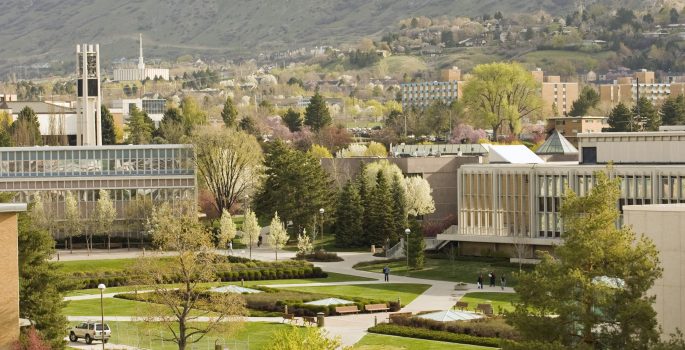
ACLU Files Lawsuit Against Colorado Town for Canceling Native Artist’s Residency Program

**Native Artist Danielle SeeWalker Sues Town of Vail Over Residency Cancellation, Citing Free Speech Infringement**
In a significant case that intersects art, free speech, and political expression, Húŋkpapȟa Lakȟóta muralist and activist Danielle SeeWalker has initiated a lawsuit against the town of Vail, Colorado, alleging a violation of her First Amendment rights. The legal battle stems from the abrupt cancellation of her summer residency in the Vail Artist in Residency program, following community complaints about one of her works that referenced Palestinian solidarity.
### The Backstory: Residency and Removal
In May 2023, while en route on a flight, SeeWalker received an unexpected and disheartening message from a staff member of the Vail Artist in Residency program. Her participation had been canceled due to concerns raised by some members of the local community about one of her personal artworks, “G is for Genocide,” which depicts a Native American woman adorned with a **keffiyeh**—a scarf associated with Palestinian identity.
The artwork, which references both the oppression of Native Americans and solidarity with Palestinians, had no direct connection to her planned residency. SeeWalker’s residency was to focus on a mural project highlighting Native American culture, distinct from the politically charged subject of her controversial work. However, a complaint lodged by local Rabbi Joel Newman took issue with the painting’s supposed defense of what he called “the claim that Israel was committing genocide,” sparking backlash from parts of the community. As a result, the Vail City Council, which oversees the town’s Art in Public Places program, decided to cancel her residency.
### Legal Action: The ACLU Steps In
Represented by the American Civil Liberties Union (ACLU) of Colorado, SeeWalker is suing the town. Her lawsuit argues that Vail violated her constitutional rights to free speech under both federal and state law by retaliating against her for expressing her viewpoints, ultimately canceling the residency. “They really wanted diversity to be an integral part of their program,” SeeWalker remarked, emphasizing that it was no surprise she tackles “controversial topics” about historical injustices facing Native Americans, among other issues.
The ACLU’s case centers on the core issue of artistic freedom and the safeguarding of controversial speech, particularly in publicly funded art programs. The lawsuit seeks both monetary damages and legal relief to prevent future acts of “viewpoint discrimination” by the town of Vail in its Artist in Residency program.
### The Artwork in Question: “G is for Genocide”
SeeWalker’s painting, **”G is for Genocide,”** mixes acrylic, aerosol, and oil stick on canvas, depicting a Native woman with a definitive keffiyeh—a symbolic nod to the Palestinian struggle and a broader exploration of indigenous identity and resistance. The artist explains that the work was born out of the emotional turmoil she felt upon witnessing reports of Israel’s bombardment of Gaza, drawing parallels between the historic displacement of her Native American people and ongoing Palestinian suffering.
Although SeeWalker affirms that the painting was a “standalone piece,” unconnected to her residency project, its visibility on her Instagram page triggered backlash. Overwhelmed by the shared history of resistance, she had even sold prints of the artwork to raise funds for the United Nations Crisis Relief’s humanitarian efforts in Gaza.
### The Fallout: A Chilling Effect on Free Speech?
According to the lawsuit, SeeWalker had already made logistical and financial commitments to the Vail residency. She had created a preliminary design for her mural, purchased supplies, and had her artwork prepared for display in a planned exhibition. Her work as a resident artist was intended to focus on Native American artistry and its cultural significance. “I kept thinking to myself how devastating this is, the stories I was hearing and the displacement of these people,” SeeWalker explained, emphasizing that she was simply channeling personal emotions about global events in her personal artwork.
The unprecedented cancellation of the residency, which was publicized to the town’s newsletter subscribers prior to the incident, prompted several law firms to reach out to SeeWalker. They alerted her that the town’s actions could indeed be unlawful. These experts suggested the town’s decisions caused her “injury that would chill a person of ordinary firmness from continuing to share views on current events,” marking a significant constitutional concern.
### Artists and Activism: The Risks of Public Programs
This legal tussle opens up a broader question about the role of art in addressing uncomfortable social and political truths. Art, widely regarded as a medium of free expression and reflection on societal issues, has long been part of both personal introspection and public discourse. But SeeWalker’s case demonstrates the potential vulnerability of controversial viewpoints even in spaces supposedly positioned to protect creativity.
Despite an initial assurance that there would be no restrictions on what she could paint as part of her Vail residency, SeeWalker was ultimately silenced for a piece *wholly unrelated* to the work